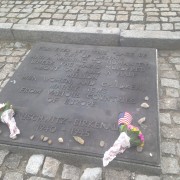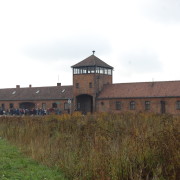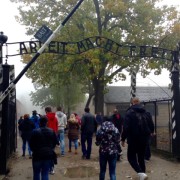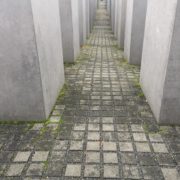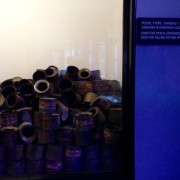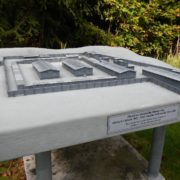The Impact of Auschwitz
By Emily Nestler
The devastating story and journey of the Holocaust began at train stations across Europe as Jews were forcefully removed from their homes, shunned from society and deported from their country. Our group began to understand the events that took place during the rise of the Nazi regime and the beginning of World War II at “Gleis 17” memorial at the Grunewald station in Berlin Germany. Although many Jews torment began in different areas across the continent, a majority experienced a similar fate as they found themselves entering a concentration or death camp, such as the one we visited, Auschwitz-Birkenau. There, as inmates, they would live out the remainder of their time in helpless fear and starvation. Today, the Nazi death camp in Poland serves as a site for tourists, who are inspired to visit for a diverse range of motives, which is evident by the way they behave during their visit. We, as students, arrived at Auschwitz with hope to develop a deeper understanding of the injustices and inhumane practices that took place here during World War II and remember those who fell victim to the wrath and blame of the Nazi regime.
On the way to the camp, I thought of all the times I’ve took note of, studied or learned of what had happened in this very location. Whether it was a textbook at school, a journal of a survivor, or a documentary on TV, all told a similar story of tearing families and friends apart, leading the victims to their death and the able, to work. I thought that through this knowledge I was prepared for our tour through the camp. But as I learned shortly after arrival, no amount of knowledge or expertise on the subject matter can prepare you for the emotion you feel as you enter through the gate that reads “work will set you free” of the place that would destroy the lives of more than a million innocent men, women and children.
Several moments during the initial tour through the main camp, Auschwitz I, I felt an uneasy sense of disbelief as the different exhibits of the museum truly exemplified the amount of destruction that took place here. One of the first rooms we visited, behind a wall of glass, stood a mountain of human hair. As I stared through the glass, I thought of the tactics the Nazis used to dehumanize their victims, stripping them of every portion of their former self and individuality. A room with a similar eerie feel held thousands of pairs of shoes, varying in size, that were confiscated from the men, women and children on arrival. Again staring through the glass at the belongings of the victims, I thought of what it would have been like to walk in their shoes and experience the overwhelming fear, confusion and infuriating helplessness that infiltrated their world. The following rooms displayed confiscated suitcases, kitchen utensils and Jewish prayer shawls that were taken from their owners, further displaying the large number of individuals who suffered. Slowly and quietly, we walked to another building within Auschwitz I where a series of home videos and photographs from the Jewish families flashed along the walls, a portion of the museum I greatly appreciated. With this addition, the victims of the Holocaust are recognized as real people who, before their deportation, lived, loved and laughed with families and friends. I appreciated the museum recognizing them as being greater than the unfortunate events they experienced. They should not solely be remembered as victims but as the people they were before the Holocaust. This exhibit allowed the people to reclaim their identities that the Nazis had attempted to erase. It countered the Nazi’s claim that the Jews were not people, that they were only capable of evil and should be blamed as the scapegoat for the problems Germany faced. Being there at the exhibit, it made it more unfathomable how the Nazis perceived these people as enemies. This portion of the museum, contrasting with the anguish and sorrow felt throughout the camp, provided a glimpse of hope for the people who experienced the exhibit.
However, my hopeful outlook was short lived as we ventured further throughout the camp. Just above the room of home videos, video clips of Nazi’s spreading their hate speech to an adoring public of radical German citizens emerged on the screen. When studying this topic, I have always been confused and baffled by how the support for these ideologies emerged. I understand that Germany was in turmoil due to unwillingly taking responsibility for the first World War. I understand that the Treaty of Versailles forced Germany to dismantle its military, decrease the size of the country, and pay reparations to other nations. I understand that the German citizens lived in a state of poverty and for that they were angry. However, I do not understand how a regime that would eventually perpetuate genocide was democratically elected into power. Through a lens of confusion and disbelief, I watched as the citizens on the screen cheered when their elected leader spoke to them, showing their support through the infamous symbol of an outstretched hand accompanied by the slogan “Heil Hitler.” I do not remember the exact words that Hitler spoke in those replayed clips, but I will never forget the way in which the people reacted, acting as though they had just heard the greatest idea they would ever hear, the solution to all their problems. And then it dawned on me that that is exactly what they thought they heard. The only way to end their own suffering was to exterminate the people I had just seen in the room below, the women laughing, the child on the beach, the ones in the family portrait, the Jews. I honestly do not think I could ever understand.
As powerful as both those rooms were, the gas chamber, the last portion we visited in Auschwitz I, created an indescribable feeling. As I walked into the chamber encased in cement walls, I once again felt a mixture of disbelief, sorrow and anger. I thought to myself, how could this be real? How could I be standing here? Here, in just one of the chambers at Auschwitz, a camp where over a million people perished? Before walking in, we were reminded that the victims were informed that they would simply be taking a shower. The Nazi’s went as far to place shower heads on the ceilings to further prevent a chaotic scene. The Jews were instructed to strip their clothes and pack themselves tightly into this darkened room, where a man would then poured zyklon B through a hole in the ceiling resulting in an agonizing death as some would suffocate for as long as 40 minutes. A few steps to the left of the gas chamber, stood the crematorium, an image that will forever be engrained in my memory. I could only bear to stay in that space for a brief moment. From here, we made our way to Auschwitz II Birkenau.
Auschwitz II Birkenau conveyed a similar sorrowful feeling as we stood in all the spaces that millions have stood before us. However, it seemed as though the tourists visiting the camp did not understand the severity of the events that transpired on these grounds. As we walked into Birkenau, I was struck by the noise level of the tourists. Those around us talking and chatting as if they were at a park catching up with a friend threatened to weaken the impact of the camp. I watched as one women placed her hand on the replica train wagon that represented the vehicle that brought over a million of people to their place of death. We were standing on the platform where the initial screening process took place. Those who were deemed capable of work were sent in the direction of the registration building. But those deemed incapable, especially pregnant women, children and the elderly, were sent in another direction, towards the “showers.” Now, this woman with her hand on the cart, then proceeded to pose for the camera as her friend snapped a photo. She deeply misunderstood the purpose of preserving this place of tragedy and remembering the victims of the Holocaust. As tourists, we tend to feel the need to document where we have been. However, at Auschwitz, we must all be students, silently taking in the surroundings, learning about the events that transpired and remembering the victims. As we slowly made our way through both camps, our group neglected to snap a single photo. As we believe, it is much less important to document the fact that we stood on this platform in 2017, but history must be preserved so we remember those who stood there from 1941 to 1945.


